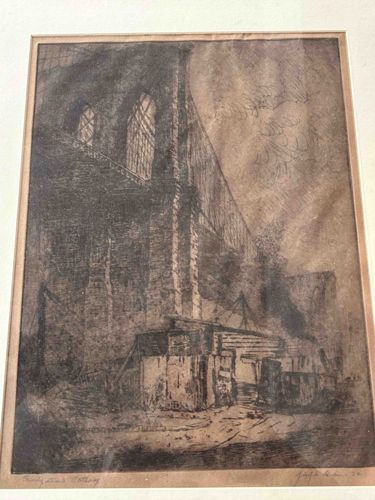
Etching depicting a large industrial or architectural structure with smaller ancillary buildings
This is a framed etching, likely on paper, depicting a prominent architectural or industrial structure dominating the scene, possibly a bridge tower or a large building, characterized by its imposing vertical lines and arched windows. The etching uses a monochromatic palette, primarily shades of brown and sepia, achieved through the etching process on aged paper, contributing to a muted and perhaps somber aesthetic. The paper itself shows signs of age, with a visible uniform darkening or toning across its surface, suggesting it is an older piece. The texture of the paper, seen through the etching, appears slightly coarse. The artwork is framed, though the frame itself is largely obscured by the matting, which is a light cream or off-white color. The etching technique is notable for its fine linework and cross-hatching, which creates depth and texture, particularly in the darker areas of the main structure and the surrounding ground. In the foreground and mid-ground, there are smaller, more crudely constructed buildings or shacks, which appear to be constructed from various materials, possibly wood or corrugated metal, with visible support structures and uneven roofs. These smaller structures provide a stark contrast in scale and style to the grander edifice behind them. There's an overall impression of an industrial or urban landscape, possibly depicting a construction site or an area adjacent to a major infrastructure project. The condition suggests typical age-related wear, including the uniform toning of the paper. There are visible signatures or inscriptions in the lower margin of the etching. On the lower left, text appears to read 'Brooklyn Bridge etching', and on the lower right, there is a signature that seems to be 'Joseph Pennell' followed by a date, possibly '1920'. This suggests an American origin and a specific artist, Joseph Pennell, known for his urban and industrial landscapes. The style of the etching, with its detailed yet somewhat gritty portrayal, is consistent with early 20th-century American realism or impressionism in printmaking. The craftsmanship is evident in the detailed rendering and atmospheric quality achieved through the etching medium.
AI-Generated Appraisal Disclaimer
Estimated Value
$800-1,200
Basic Information
Category
Fine Art Print
Appraised On
November 14, 2025
Estimated Value
$800-1,200
Item Description
This is a framed etching, likely on paper, depicting a prominent architectural or industrial structure dominating the scene, possibly a bridge tower or a large building, characterized by its imposing vertical lines and arched windows. The etching uses a monochromatic palette, primarily shades of brown and sepia, achieved through the etching process on aged paper, contributing to a muted and perhaps somber aesthetic. The paper itself shows signs of age, with a visible uniform darkening or toning across its surface, suggesting it is an older piece. The texture of the paper, seen through the etching, appears slightly coarse. The artwork is framed, though the frame itself is largely obscured by the matting, which is a light cream or off-white color. The etching technique is notable for its fine linework and cross-hatching, which creates depth and texture, particularly in the darker areas of the main structure and the surrounding ground. In the foreground and mid-ground, there are smaller, more crudely constructed buildings or shacks, which appear to be constructed from various materials, possibly wood or corrugated metal, with visible support structures and uneven roofs. These smaller structures provide a stark contrast in scale and style to the grander edifice behind them. There's an overall impression of an industrial or urban landscape, possibly depicting a construction site or an area adjacent to a major infrastructure project. The condition suggests typical age-related wear, including the uniform toning of the paper. There are visible signatures or inscriptions in the lower margin of the etching. On the lower left, text appears to read 'Brooklyn Bridge etching', and on the lower right, there is a signature that seems to be 'Joseph Pennell' followed by a date, possibly '1920'. This suggests an American origin and a specific artist, Joseph Pennell, known for his urban and industrial landscapes. The style of the etching, with its detailed yet somewhat gritty portrayal, is consistent with early 20th-century American realism or impressionism in printmaking. The craftsmanship is evident in the detailed rendering and atmospheric quality achieved through the etching medium.
Get Your Items Appraised
Instant estimates of your treasures with AI-powered instant appraisals